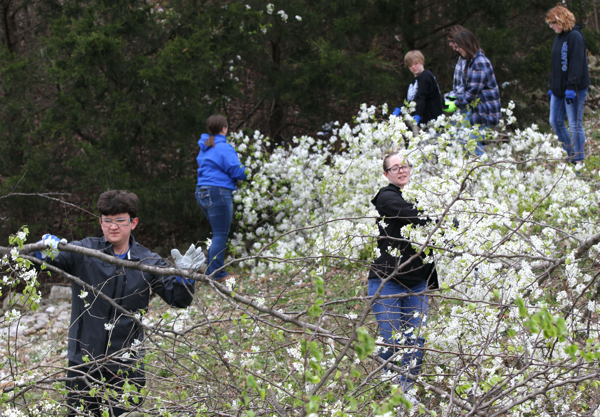
A voluntary group of students and district personnel has begun to remove hundreds of non-native, invasive pear trees from the Poplar Bluff High School campus.
The PBHS Science and Environment Club partnered with the FFA to take on the project on Sunday, March 27, soliciting help from the Maintenance Department, among other individuals.
“It matters to our students,” explained PBHS biology teacher Gretchen Pendley, who sponsors the club. “We can’t fix all the big problems, but we can do some small work.”
Two years ago the Science Club, which concentrated mostly on chemistry, expanded to consider issues related to human impact on the environment, according to Pendley. The new organization decided to start by making a difference in their own backyard, but the pandemic caused the postponement of their first major project.
PBHS agriculture teacher and FFA sponsor Kathryn Clark said that Callery pear trees, better known as Bradfords, have been on her radar since the campus relocation of 2016. “It’s a beautiful campus, but we also want it to be sustainable and environmentally friendly," she said. "Bradfords do more damage than good."
Native to China, the white flowering trees are popular for landscaping because of their “ornamental value,” according to junior Emmalein Pendley, Environment Club vice president, but they have no “wildlife value.” They crowd out habitats needed by birds and wildlife, out-competing native vegetation for light, water and nutrients, according to state conservation experts.
In addition, Bradfords have “no predator” or natural enemy, said Gretchen Pendley. The aggressive Callery pears were made available here in the 1950s because of their resistance to diseases such as fire blight. They became invasive when new cultivars cross-pollinated with the commercial variety, producing trees bearing small fruit with viable seeds that birds such as starlings eat and spread, allowing for escaped trees, according to the University of Missouri Extension.
Lastly, Bradfords are “weak trees,” Clark went on. Since they are known to grow quickly with poor branch angles, the soft-wooded limbs are often split in high winds, according to the Missouri Department of Conservation. The expansive root system, partial to soil types common in the Midwest, deems the tree difficult to kill
R-I Maintenance Supervisor Colt Sievers headed up the eradication last weekend, along with his brother David, PBHS health teacher and football coach, later disposing of the downed trees with a tractor and grappling hook at an approved burn site. Sievers said treating the stumps with herbicide would also be necessary to destroy the root.
“Education and learning to be good stewards” will be essential going forward, since “one day I will be too old to hold a chainsaw,” Sievers pointed out. He joked how his daughter Audrey, a PBHS junior, informed him what he would be doing with his time that day and he simply agreed. “I was volun-told,” he continued.
Incoming president for Missouri FFA Area 16, Audrey Sievers completed a supervised agricultural experiment over the summer involving a pesky weed known as sericea lespedeza also identified on the hillside east of campus, and her father helped her get its spread under control as well. She admitted that prior to educating herself on its ecosystem, she—like many—just thought the Bradfords added some color to campus.
“If it’s not helping, we don’t need it; it serves no purpose,” Audrey Sievers said. “It’s a long process, but if we start working toward a goal now, future generations will benefit.”
Alternative options of flowering trees, the group variously suggested, include Eastern redbuds, dogwoods, tulip poplars, white fringe trees and serviceberries. The Missouri Invasive Plant Task Force, formed several years ago, is collaborating to host buy-back events later this month throughout the state, including in Cape Girardeau, to replace Calleries cut down by property owners with free native trees. Visit moinvasives.org for more information about state invasive species management efforts.
PBHS students drag Bradford limbs cut down around Mules Stadium by David and Colt Sievers to a large pile.
Pictured: With the supervision of teacher sponsors, students volunteer to gather clipped branches along the Oak Grove Road campus on a recent Sunday afternoon.
Article and photo by Tim Krakowiak, Communications/Marketing Director, Poplar Bluff R-I School District

Congratulations to Tyson Carmode and Korbin Williams, Dexter High School students, on placing 1st in Computer Gaming and Simulation Programming at the state of Missouri Future Business Leaders of America conference in Springfield. Nationals are in Chicago this summer!!
Photo submitted.

Bloomfield, MO - Bloomfield Reorganized School District XIV held their April meeting on Monday evening.
Board Secretary Justin Bell, was on hand to swear in the two new board members, David Clary and Brooke Smith.
The Board also elected officers. President is Brad Warner, Vice President is Cecil Haley, Treasurer is Bill Robinson, and Secretary is Justin Bell.
The Board approved the minutes of the Board Meeting of March 14, 2022.
The Board set the Budget Workshop Date and the May Board meeting for Noon on May 11th. Budget Workshop usually takes about two hours and the Board meeting will follow.
There was some discussion on the Agriculture Shop expansion. Around 1,800 square feet will be added and they will possibly put that out for bid in August. They are still working on the details. Also there was discussion of the Bus Garage. They hope to get 9 buses at a time in the garage. Currently they have 10 buses in operation.
Toni Hill, Superintendent, stated that there were two summer projects on the agenda. Workroom remodels for all three buildings and will be paid for by a Teacher Retention Grant and the Central Office will have some updates as well.
The superintendent gave her report on a few budget bills in the legislature and HB 1552 as well. They then entered into Executive Session to discuss employment matters.

Bernie R-XIII School District Board of Education Meeting Proposed Agenda - April 11, 2022

Dexter, MO - Central Elementary 5th Grade students presented "Pirates!" featuring the homeroom classes of Mrs. Allen, Mrs. Lummukka, Mrs. Miller, and Mr. Scott on March 29, 2022.
The Songmakers also performed singing the "Best Day of My Life" featuring soloists Ella Masters, Charlotte Hurt, Kennedy Essner, Dani Noble, Robin Ordway, and Lana Rangel. They also sang "Pirate Story", "In the Arms of an Oak", and "God Bless America" featuring soloists Selah Sepulvado and Olivianna Hester.
Part 1 students: Kingston Banken, Zander Boyer, Easton Bryant, MaKinley Crosby, Addelyn Gill, Addilyn Gordon, Olivianna Hester, Sam Howard, Ella Hutson, Ada Jarrell, Lily McCord, Jiles Monroe, Marlie Morris, Dani Noble, Robyn Ordway, Lana Rangle, Selah Sepulvado, Zoey Smith, Ronie Taylor, and Blaiklyn Webb.
Part 2 students: Kennedy Esner, Hailey Foster, Bryan Galloway, Chase Gibson, Lilah Grimes, Gabbie Guethle, Greta Guethle, Harley Haws, Amia Howard, Charlotte Hurt, Zachary Jackson, Ella Masters, Clayton McGowen, Sebastian McRoy, Addison Meador, Jett Mosier, Blake Pfeffer, Silas Pfeffer, Bailey Stevens, Lexi Underwood, and Addilyn Williams.
Cast:
Stowaway: Amia Howard
King of the High Cs: Jett Mosier
"Pirates All Are We" - Speakers: Silas Pfeffer, BA Templemire, Carter Claussen, Kyle Harris, Ella Masters, McKendree Neuhaus, Billy Busse, Melora McKay, Tyler Hankins, and Zane Ruppel.
"Stowaway" - Soloist: Amia Howard, Speakers: Charlotte Hurt, Gabbie Guethle, Hunter Spain, Lilah Grimes, Owen Reed, Brye Josupait, and Mason Monroe.
"King of the High Cs" - Soloist - Jett Mosier, Speakers: Beau Craft, Owen Reed, Mason Monroe, Hayden Wilson, and Mila Clark.
"You Wanna Be a Pirate" - Soloists: Jett Mosier and Amia Howard, Speakers: Payden Fowler, Bailey Stevens, Annabell Meredith, Greta Guethle, Taron Deprow, Ava Parker and Harley Haws.
"Lost at Sea" - Soloist: Ania Howard, Speakers: Kolby Roberts and Kenton Barbour.
"Singing a Pirate Song" - Soloist: Jett Mosier, Speakers: Zander Boyer, Eben Carr, Garan Wheeler, Addelynn Gill, Robyn Ordway, Lola Barr, Blaiklyn Webb, Reed Dodson, and Alexandria Budde.
Mrs. Allen's Homeroom Class: Lola Barr, Zander Boyer, Alexandria Budde, Eben Carr, Reed Dodson, Peyton Dudley, Megan Evans, Addelynn Gill, Braxton Graves, Kamden Hottinger, Lily McCord, Ivory Motes, Hunter Nation, Robyn Ordway, Eli Reeves, Eric Sanders, Cordilia Smith, Mason Smith, Blaiklyn Webb, and Garan Wheeler.
Mrs. Miller's Homeroom Class: Kenton Barbour, Jacey Church, Taran Deprow, Macian Dobbs, Eli Earnheart, Lily fields, Hailee Foster, Payden Fowler, Elliott Goldschmidt, Greta Guethle, Leevi Hampton, Madyson Harris, Harley Haws, Zachary Jackson, Sebastian McRoy, Annabel Merideth, Kyle Nichols, Ava Parker, Kolby Roberts, Bailey Stevens, and Alison Stonis.
Mrs. Lummuka's Homeroom Class: Marty Bartlett, Mila Clark, Beau Craft, Grace Cobb, Chase Gibson, Michael Glore, Lilah Grimes, Gabbie Guethle, Farrah Hofer, Amia Howard, Charlotte Hurt, Bryce Josupait, Clayton McGowan, Khloe Merritt, Mason Monroe, Jett Mosier Gracy Neal, Owen Reed, Hunter Spain, and Hayden Wilson.
Mr. Scott's Homeroom Class: Brylee Burleson, Billy Busse, Carter Claussen, Ella Masters, Anthony Fino Lara, Miley Gold, Tyler Hankins, Kyle Harris, Jayden Johnson, Kayleen Kingston-Horn, Aiden McClish, Mlora McKay, Addison Meador, McKendree Neuhaus, Silas Pfeffer, Mahala Quails, Faith Riddle, Zane Ruppel, BA Templemire, and Emmarie Watkins.

